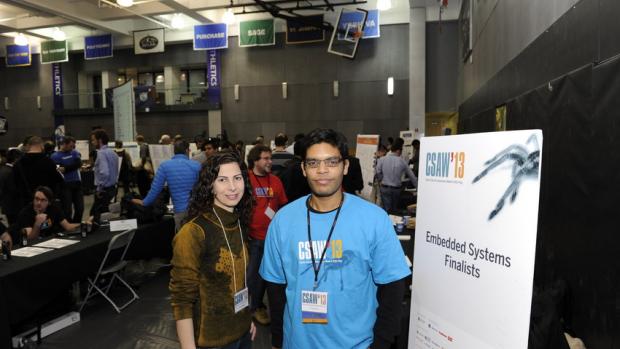Cyber Security Awareness Week Marked Its 10th Anniversary by Being Bigger and Better than Ever

The Capture the Flag (CTF) teams gathered at the Polytechnic Institute of New York University (NYU-Poly) Jacobs Gymnasium didn’t have time to talk or even give their names, so intently were they working to solve the applications security challenge set forth for them as part of NYU-Poly’s Cyber Security Awareness Week (CSAW). While they politely declined to chat, one member of PPP1, a team from Carnegie Mellon, quipped, “But why not go over to distract some of our rivals?”
That intense focus paid off for PPP1, which took second place in the contest.
Even around the lunch table, focus was the order of the day. Alan Schorn, a teacher at Great Neck North High School, on Long Island, had shepherded his High School Digital Forensics (HSF) team in to eat, and while they didn’t mind chatting, not one team member would discuss what progress they had made in analyzing the digital evidence that would allow them to solve a virtual mystery at the heart of the competition. “You don’t know who could be listening,” Daniel Hanover, one of Schorn’s charges, warned. “And you don’t want to give away any clues.”
Schorn was not new to Poly; he had been here over the summer, taking part in a boot camp for teachers, meant to help them encourage their students to pursue careers in cyber security and other STEM fields. Two of his students, Ashley Radparvar and Jessy Lin, had attended the CSAW summer boot camp for girls and had eagerly agreed to return to NYU-Poly as part of a Great Neck team. “I was not interested in cyber security until I came here over the summer,” Ashley said. So much so, that after lunch, she began browsing the career fair booths set up around the Regna Lounge. Eying the tempting piles of swag at the Facebook table but assuming the company was looking for college-age interns, she started to walk away. That was only until Chanel Kramer, the recruiter manning the table, stopped her and explained that there were, indeed, opportunities for bright, motivated high school students—just like the ones at CSAW.
Kramer wasn’t the only one impressed by the CSAW participants. Reiner Sailer, a manager at IBM’s T.J. Watson Research Center, had agreed to be one of the judges of the Best Applied Research Paper competition, and he acknowledged that the contestants had their work cut out for them. “They not only have to do the research and complete the paper, they also have to present it to the judges, which requires public speaking and the ability to represent your work well,” he said. “These are impressively multi-talented people.”
That talent was also in abundant evidence during the Embedded Systems Security Contest, which tests knowledge of hardware security and the ability to detect malicious flaws and protect chips. “We can disable your device, make it output gibberish, exploit any weakness we find,” Chandra K.H. Suresh explained. He was part of a team from NYU Abu Dhabi, evocatively called the Attackers. “Of course, we’re just pretending to be bad,” Samah M. Saeed, his teammate and an aspiring academician, laughed. “If we can show where the loopholes in a system are, then they can be fixed.”
That CSAW attracted Saeed, Suresh and hundreds of other talented, young experts undeniably bodes well for the future state of cyber security.
For more about CSAW and the winners, click here.




